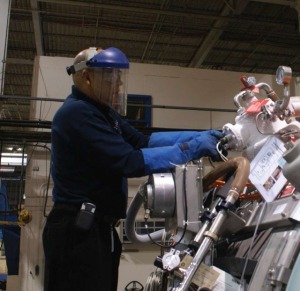by
Keith Loria, Reporter | February 26, 2010

A technician at Oxford
Instruments checking helium
levels
This report originally appeared in the February 2010 issue of DOTmed Business News
Industry experts estimate that as we enter the first year of the new decade, helium consumption measures about 120 million cubic meters a year and should continue rising a few percentage points a year over the next decade. That's almost a 50 percent increase in helium use from when the millennium began. Of course, this large growth has a lot to do with advancements in MRIs, since helium is used as a coolant for the superconducting magnets in this equipment.
According to Thomas Freund, general manager of MRI Services for Oxford Instruments, it's vital those working with MRIs deal with this equipment properly and hire knowledgeable companies to check on helium levels and other aspects of the cooling and keep-cold systems.




Ad Statistics
Times Displayed: 19090
Times Visited: 362 Stay up to date with the latest training to fix, troubleshoot, and maintain your critical care devices. GE HealthCare offers multiple training formats to empower teams and expand knowledge, saving you time and money
"As magnet designs evolve it becomes more and more important to fully understand the procedures required to both cool down magnets as well as to perform routine top-offs," Freund says. "Using the equipment designed for the appropriate magnets is also essential."
A big boon to the industry concerns advancements of MR systems, which now expend less helium to keep them operational.
"This equipment being put on the magnets has greatly reduced the cryogenic consumption," says Robert Hoffman, general sales manager for Huntley, Ill.-based Genesis Magnet Services. "They used to require a helium fill two or three times a year. Now with the ultra-efficient equipment the refill may be once every three to six years. The demand has subsided greatly in the installed base of MRs."
The emergence of 4K magnet technology requires less helium top-off but at the same time, more monitoring of the critical systems that keep an MRI magnet cold and operational. Customers who implemented the 4K technology are seeing that the new technology required immediate response to problems, even though they didn't have to look at cryogen levels every day.
Helium Supply
It was only two years ago when a panic hit U.S. cryogen companies over the fear helium was in short supply. The Federal Bureau of Land Management was reporting their reserve-which sits on a pipeline that runs on the northwest side of Amarillo, Texas, across Oklahoma and into Kansas-was running out.
Linde bulk helium containers
hold approximately 11,000 gallons
of liquid helium.
"The big panic was that the Bureau of Land Management had stockpiled helium in the '40s that the companies had been drawing on, and suddenly it started to run out and there was a panic to find other resources," says Freund. "New refineries have been built now [not in America], so there is plenty to go around."

